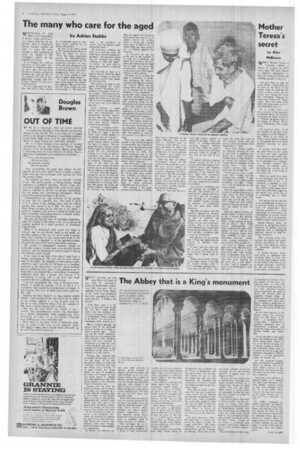Page 4, 4th August 1972
Page 4

Report an error
Noticed an error on this page?If you've noticed an error in this article please click here to report it.
Tags
Share
Related articles
Macao Refugees Swim From China
Mis Only Worry Is Where The Next 2051 Meals Are Coming From.
Help From Britain
Jesuits Still All Things To All Men
Old People's Meagre Rations Cut By One Third
The many who care for the aged
by Adrian Stubbs
WHENEVER Fr. Luis Ruiz. of the Cassa Rizzi in Macao. writes of his work, you cannot help but be impressed. He's an impressive 'person because, against all odds, he cares. He cares enough to help thousands of needy old people in this Portuguese island off the mainland of China.
If he thought the problems presented to him were insurmountable he would have given up years ago. But he cares enough to continue, perhaps in the .hope that one day life for the islanders will cease to be a perplexing struggle and that living in Macao will take on a new dimension.
For too long, since the days they fled from China during the Communist takeover. they have known nothing but injustice and poverty.
In one of his many letters to the London-based offices of Help the Aged, he writes: "With the rapid population growth, the disproportionate economic development and the lengthened life-span, we have more and more old people with no one to care for them. Even if they have relatives. the latter, struggling for their own survival. are often unable to help and so neglect their elderly."
Fr. Luis is anxious that the aged in his district feel wanted. not neglected. He provides hostels for them which are now overcrowded — "the beds are even in the corridors," he writes. "but the inmates think themselves lucky."
He distributes clothing, but there is a need for more. He undertakes massive feeding programmes. and hundreds queue for their monthly rice ration. "Thanks to Help the Aged." he writes. "we were able to give a special meal to 1.200 old people."
For as long as there is a need in Macao, Help the Aged intends to continue to send the aid which. says Fr. Luis, makes his work possible.
The picture of need is the same throughout the world. The 'Mother Provincial of a hospice in Karaikal, South India. writes: "This hospice was originally built to house 60 old people but today there are over 100. It is overcrowded and this is the only work of its kind in the area."
From Vietnam. a relief worker reports that aged refugees are experiencing "unaccountable distress. misery. poverty and fear. Any aid in the form of clothing, blankets. food and medical supplies would be appreciated."
In Malawi, a Catholic worker writes: "Without the assistance of Help the Aged I do not know what would happen to our people who are in need."
Cardinal Heenan said at the recent annual service of Help the Aged in London : "We are going through a phase in social history when the insults are reserved for the Institutional Church, so it is just as well to remember that most of the work for the aged is organised by religious institutions, and most of the work for the afflicted, both young and old is carried out by practising members of religious communities."
Last year Help the Aged increased its aid to 44 countries where there are devoted relief workers like Fr. Luis to receive consignments of clothing. blankets and grants for food and medical supplies. Many Catholic churches are involved in
Help the Aged's nationwide appeal programme and act as reception centres for clothing which is being sent overseas every week. A third of the aid which Help the Aged sends is sent to Catholic agencies and missions.
To promote old age the world over by the example of its work as a satisfying and useful time of life is the enormous task which Help the Aged has set itself. This means that communities throughout the world must realise their responsibilities to their elderly.
Overseas. as far as Help the Aged is concerned, it necessitates entrusting aid with recognised relief agencies (Caritas and Catholic Relief Services among them) who treat the old not as outcasts but as valued members of the community people like John Laiken at the Oje River Settlement. Nigeria, where Help the Aged is periodically providing funds for the chronically sick elderly patients.
Here, Mr. Laiken has workshops for those in his care. manufacturing brushes, baskets and specially designed footwear for the aged leprosy patients.
Mother Teresa of Calcutta says: "The biggest disease today is not leprosy or tuberculosis. but rather the feeling of being unwanted, uncared for and deserted by everybody." Tragically, this applies as much to this country as it does to Calcutta.
There are now nine million people in the United Kingdom of pensionable ages Population figures show the present annual increase of 110,000 will continue during the 1970s. The specific housing needs of the elderly have been seriously underestimated and in some areas almost totally neglected.
This means that a large number live in sub-standard conditions in decayed premises. Just how sub-standard can he seen by taking three basic amenities: a kitchen, an indoor lavatory, the use of a bathroom. More than 350,0(10 lack all three of these amenities; 1,281,000 lack two of them. That housing is the single common denominator of hard ship which compounds all the other difficulties old people face is blatantly clear in "Granny Come Home", a report published by Help the Aged, It stresses that nobody knows how bad the conditions of Britain's aged really are. This alone is disquieting.
There has been no official Government survey of the needs of old people for years. But such private studies as have been carried out indicate a pretty disgusting situation. More than 1,300,000 old people live alone. The old are the poorest section of the community. Over two million draw supplementary benefit. A third of a million people urgently need sheltered housing.
Help the Aged sees the mac tical and realistic answer in sheltered housing. These are blocks of warden-supervised specially designed self-contained flats. Help the Aged's Housing Association will have rehoused 2,000 old people in this way by the end of this year.
A typical sheltered housing scheme consists of 24 to 36 purpose-built flats together with common rooms and warden's accommodation. Flats are unfurnished so that tenants may have their own possessions around them. and where income is too low to meet economic rent, supplementary benefit is arranged.
All services. including central heating, are included in the rent. The tenants are responsible for looking after their own flats and for shopping and cooking for themselves. The resident warden provides an element of background care and gives help where necessary.
The flats are linked with the warden's quarters by two-way intercom, so that there can be no fear of isolation. All schemes are built close to shops, services and community activity. This is an environment designed for independent living but providing also cornfort, warmth, friendliness and a sense of community.
June Brown said on moving into a Help the Aged housing scheme in Burnley, Lancashire: "I can't tell you what it's like to have a place like this for my home. It's made me so happy that I never want to leave.
"Before this it wasn't living: it was sheer misery. I was cut off, lonely, always cold. I can't remember getting into a warm dry bed for years." The water ran down the walls in her terraced house and she wore an overcoat indoors from September to May.
When Mrs. Brown applied for sheltered housing she was ill and lived in appalling conditions in a damp basement. Despite being a State Registered Nurse. she couldn't cope. "I had all the livestock of the nation there — lice, cockroaches, worms, ants: you never get rid of the lice."
There was an oil fire, a bathroom "like a fridge" and her lavatory was outside. "I had the people of the Whole house trampling through." Today she is not recognisable as the same person.
Help the Aged claims to have pioneered sheltered housing in some areas. Its first housing scheme was built only two years ago. yet by the end of 1971 it had over £13 million worth of housing in hand. Today that figure is over £15 million.
Help the Aged's success, its annual report is keen to stress. is not a matter for self-congratulation — "it simply reflects a huge amount of goodwill in action." Over 2,000 church congregations and other organisations gave their support in 1971 and its own Youth Campaign raised more than £100,000 in that year. Sponsored knit-ins, swims, walks, skating marathons — you name it. they sponsor it!
Fr. Luis in Macao wrote again last week. He told of an old woman "close to a hundred years old" who needed help. A policeman came to Fr. Luis to ask if he could help. "She has been sleeping in the street for a few days," he adds, "and is urgently in need of accommodation. love and care."
blog comments powered by Disqus









